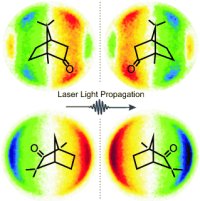 The handedness, or chirality, of nature’s molecules has fascinated chemists for decades and ever since Louis Pasteur plucked apart the left-and right-handed enantiomers of tartaric acid salts with tweezers and magnifying glass there has been an urge to find ways to understand the origins of chirality and how to manipulate it to the chemist’s own ends.
The handedness, or chirality, of nature’s molecules has fascinated chemists for decades and ever since Louis Pasteur plucked apart the left-and right-handed enantiomers of tartaric acid salts with tweezers and magnifying glass there has been an urge to find ways to understand the origins of chirality and how to manipulate it to the chemist’s own ends.
Identifying the chirality of a compound in the gas phase using light is difficult because of the low particle densities present. However, collision-free conditions could lead to highly sensitive analytical applications as well as allowing researchers to unravel fundamental aspects of the way light interacts with matter. Find out how a German team has used polarised laser light to get to grips with molecular handedness in my latest column on SpectroscopyNOW.